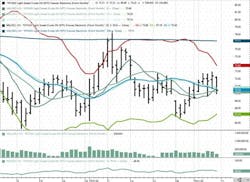Oil, fundamental analysis
Oil prices this week found support with four key events: a hurricane, the US presidential election, OPEC+'s decision to delay a production increase, and another rate cut by the Federal Reserve. All were seen as bullish for energy. However, by week’s end, it was known that Hurricane Rafael's impact on oil supply would be minimal, that inventories had increased, and that demand concerns re-emerged.
The ups-and-downs of the US dollar also added to the volatility while the Middle East conflicts appeared to take a backseat. WTI saw a High/Low range of $72.90-$69.75/bbl while Brent’s range was $76.25-$73.35. The Brent/WTI has tightened to -$3.80/Bbl. Both grades of crude look to settle higher week-on-week.
Despite moving south of the US Gulf of Mexico, safety evacuations of oil and gas platforms ahead of Hurricane Rafael did result in an estimated 22% curtailment of production. However, most production should be back in operation by next week.
OPEC+ has again pushed back its planned output increases through the end of the year amidst current price levels and market uncertainty. Meanwhile, Saudi Arabia lowered its selling price to Asia perhaps signaling concerns over market share. China has implemented more stimulus measures; however, these were seen as too small to counter the current economic woes which disappointed markets. Their imports of crude fell 9% in October, the sixth consecutive month of year-on-year declines.
While the actual impacts of the election on the oil and gas industry have yet to be seen, the market reaction was positive this week as reflected in Tuesday’s uptick. However, any measures enacted by a second Trump administration that could increase production would not be welcomed in the short-term given the on-going concerns over the global economy and declining demand. Energy futures largely trade on perception and high-frequency trading platforms only serve to exacerbate those outlooks.
The US Federal Reserve made good on its signal that it would lower interest rates again this month by announcing a cut of 0.25% this week. The subsequent strengthening of the USD has limited the election effect on oil prices.
The Energy Information Administration’s Weekly Petroleum Status Report indicated that commercial inventories of crude and refined products increased across-the-board last week. The SPR gained 1.4 million bbl to 387 million bbl. Total US oil production held at its record high of 13.5 million b/d vs. 13.2 b/d last year at this time while the rig count held at 585 total, down 31 from last year.
Jobless claims last week rose 3,000 to 221,000 vs. a forecast of 220,000. The Fed rate cut and the election results propelled the stock market higher as all three major indexes are trading at new record levels. The USD is higher on the week which has slowed the earlier week momentum for crude prices.
Oil, technical analysis
December 2024 NYMEX WTI futures contracts prices have moved above and below the 8-, 13-, and 21-day Moving Averages. Volume is rising at over 200,000. The Relative Strength Indicator (RSI) is neutral at the 49 mark. Thirty or below is considered very oversold while 70 or above is considered very overbought. Resistance is now pegged at $71.00 with near-term Support is $70.00.
Looking ahead
It’s too early to quantify the impact of the presidential election on oil prices despite moving higher this week in tandem with the stock market. On the one hand, the expectation of looser industry regulation and the potential opening of more federal lands for drilling is positive for oil and gas. On the other hand, the imposition of tariffs could lead to higher inflation and, in the case of China, could further impact their sagging economy and lead to even lower demand for the world’s No. 1 importer of crude.
In the end, only higher prices will provide the capital needed to increase drilling and production activities and $70/bbl seems to be the 'Goldilocks' area. Traders will now return to monitoring the Israel/Iran conflict and gauge the prospect for any settlement that could come out of the new administration.
The outlook for heating oil demand in the coming weeks looks bleak. However, the Thanksgiving week will give a boost to gasoline and aviation fuel consumption.
Natural gas, fundamental analysis
Despite a kickstart to the week, December natural gas can’t maintain prices above $3.00/MMbtu as the storage surplus continues to build and consumption lags. The week’s High was $2.82/MMbtu on Tuesday while the Low was Friday’s $2.64/MMbtu.
Supply last week was -1.3 bcfd to 107.8 bcfd vs. 109.1 the prior week. Demand was 101.4 bcfd, up from 100.4 bcfd the week prior with increases in residential usage and power consumption.
Exports to Mexico were 5.8 bcfd vs. 6.2 bcfd the prior week. LNG exports were 12.7 bcfd. vs. 13.5 bcfd the prior week.
The latest European natural gas prices were quoted at $14.00/MMbtu as the region is experiencing windless days. The EIA’s Weekly Natural Gas Storage Report indicated an injection of 69 bcf vs. a forecast of 64 bcf vs. a 5-year average of an additional 32 bcf.
Total gas in storage is now 3.932 tcf, rising to 4.2% above last year and 54.8% over the 5-year average. With the mild weather forecasted for the next 2 weeks, it is likely that we will see consecutive injections that could put storage levels at 4.0 tcf, a mark reached only twice in the past decade.
Natural gas, technical analysis
December 2024 NYMEX Henry Hub Natural Gas futures are above the 13- and 21-day Moving Averages but below the 8-day MA. Volume is lower than average at 115,000. The RSI is neutral at 54. Support is pegged at $2.65 with Resistance at $2.70.
Looking ahead
As with heating oil, the next 2 weeks don’t bode well for natural gas consumption. Continued storage injections will only suppress prices further.

Tom Seng
Assistant Professor of Professional Practice in Energy
Ralph Lowe Energy Institute
Neeley School of Business
Texas Christian University
Fort Worth, Tex.




